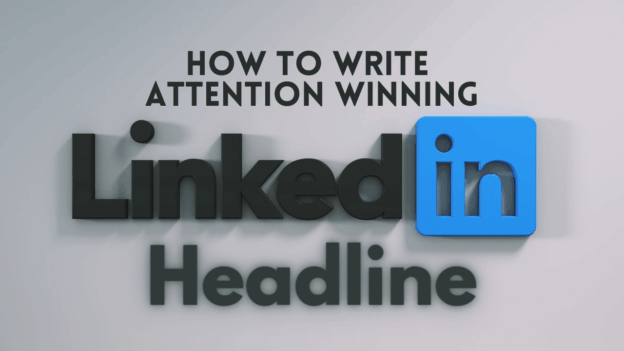Your LinkedIn headline is one of the most valuable parts of your profile. It appears next to your name in searches, connection requests, posts, and comments. In many cases, it’s the first thing recruiters or professionals notice about you.
A strong headline can increase your visibility, communicate your value, and make you stand out among thousands of candidates competing for the same roles.
Unfortunately, many LinkedIn users either leave their headline blank, stick to a generic job title, or fail to take advantage of this small but powerful section. The good news is that with the right strategy, anyone can craft a headline that grabs attention and attracts opportunities.
This guide explains why headlines matter, common mistakes to avoid, and how to write a compelling LinkedIn headline that helps you get noticed.
Contents
Why Your LinkedIn Headline Matters
Your headline is more than just a description—it’s part of LinkedIn’s search algorithm. Recruiters use specific keywords when searching for candidates. If those keywords appear in your headline, your chances of appearing in search results increase significantly.
Beyond algorithms, your headline also shapes first impressions. Imagine two profiles:
-
Headline A: “Student at University of Toronto”
-
Headline B: “Business Graduate | Skilled in Data Analytics, Marketing Strategy, and Project Management”
Which one would you click on? Clearly, the second headline communicates skills, focus, and potential.
A good headline should:
-
Include relevant keywords.
-
Highlight your expertise or career goals.
-
Differentiate you from others in your field.
Common Mistakes in LinkedIn Headlines
Many professionals unintentionally weaken their profiles with headline mistakes. Avoid these pitfalls:
-
Leaving it blank – If you don’t edit it, LinkedIn automatically shows your most recent job title. This misses the chance to stand out.
-
Being too vague – “Open to Work” or “Looking for Opportunities” tells recruiters nothing about your skills.
-
Using only a job title – While job titles are important, they don’t explain your full skill set.
-
Keyword stuffing – Adding too many buzzwords makes your headline confusing.
-
Not updating regularly – A headline that reflects outdated goals or roles can mislead recruiters.
How to Write a LinkedIn Headline That Stands Out
1. Identify Your Audience and Goal
Before writing, think about who you want to attract. Are you targeting recruiters, potential clients, or industry peers? Your headline should speak directly to them.
2. Use Keywords Strategically
Look at job descriptions for roles you want. Identify common skills and titles, then incorporate them into your headline naturally.
Example:
-
Instead of: “Marketing Professional”
-
Use: “Digital Marketing Specialist | SEO, Content Strategy, and Social Media Campaigns”
3. Highlight Value, Not Just Role
Recruiters want to know what you can deliver. Include achievements or areas of expertise.
Example:
-
“Sales Manager Helping Businesses Increase Revenue Through Data-Driven Strategies”
4. Combine Multiple Strengths
If you have expertise across areas, include them. Use separators like “|” or “–” for clarity.
Example:
-
“Graphic Designer | Branding & UX Design | Skilled in Adobe Creative Suite and Figma”
5. Add Career Aspirations (If You’re a Graduate)
If you’re just starting your career, emphasize skills and career direction instead of only stating “Recent Graduate.”
Example:
-
“Computer Science Graduate | Aspiring Software Engineer | Skilled in Python, Java, and Cloud Computing”
6. Keep It Concise and Professional
You have 220 characters. Use them wisely, but avoid jargon or irrelevant terms.
Examples of Strong LinkedIn Headlines
Here are examples across different industries and career stages:
-
For Job Seekers:
-
“Data Analyst | Skilled in SQL, Python, and Tableau | Passionate About Business Insights”
-
-
For Career Changers:
-
“Former Teacher Transitioning to Corporate Training | Skilled in Communication and Instructional Design”
-
-
For Freelancers:
-
“Content Writer | SEO Copywriting and Blogging | Helping Businesses Grow Online Visibility”
-
-
For Graduates:
-
“Finance Graduate | Skilled in Financial Modeling, Excel, and Risk Analysis | Open to Analyst Roles”
-
-
For Senior Professionals:
-
“Operations Director | Driving Efficiency and Growth | Supply Chain and Strategic Leadership Expert”
-
How to Test and Refine Your Headline
-
Check Search Visibility: Use LinkedIn’s job search to see if profiles with similar roles appear. Adjust your headline if you’re not showing up.
-
Seek Feedback: Ask peers, mentors, or career coaches if your headline is clear and compelling.
-
Update Regularly: As your career grows, refine your headline to reflect your latest skills and achievements.
Frequently Asked Questions
1. Should I mention “Open to Work” in my headline?
No. Instead, use the “Open to Work” feature LinkedIn provides. Use your headline to showcase skills and value.
2. Can I write a creative headline?
Yes, but balance creativity with professionalism. For example, “Storyteller and Content Creator | Helping Brands Build Authentic Voices” works well, but avoid casual or humorous phrases that reduce credibility.
3. How often should I change my headline?
Update it whenever your career goals, skills, or role changes. At least once a year is recommended.
4. Should I include soft skills in my headline?
Focus on hard skills and professional keywords. Soft skills like “team player” are better highlighted in your About section.
5. Is it okay to list multiple roles?
Yes, especially if you are open to different opportunities. Example: “UX Designer | Web Developer | Front-End Specialist.”
Conclusion
Your LinkedIn headline is more than just a line of text—it’s a powerful marketing tool. With the right keywords and structure, you can increase visibility, attract recruiters, and communicate your value in just a few words. By avoiding common mistakes and focusing on clarity, skills, and goals, you’ll ensure that your profile stands out in a crowded marketplace.
